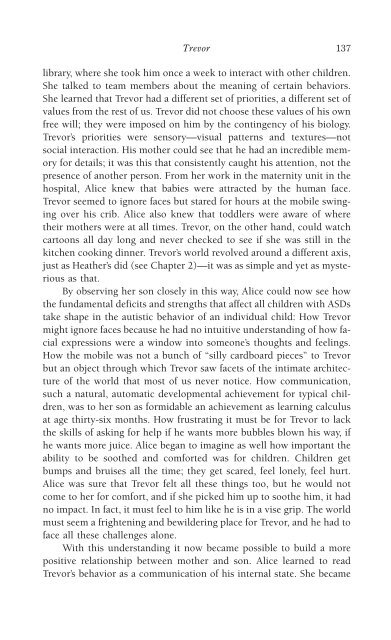978-1572305441
autism
autism
You also want an ePaper? Increase the reach of your titles
YUMPU automatically turns print PDFs into web optimized ePapers that Google loves.
Trevor 137<br />
library, where she took him once a week to interact with other children.<br />
She talked to team members about the meaning of certain behaviors.<br />
She learned that Trevor had a different set of priorities, a different set of<br />
values from the rest of us. Trevor did not choose these values of his own<br />
free will; they were imposed on him by the contingency of his biology.<br />
Trevor’s priorities were sensory—visual patterns and textures—not<br />
social interaction. His mother could see that he had an incredible memory<br />
for details; it was this that consistently caught his attention, not the<br />
presence of another person. From her work in the maternity unit in the<br />
hospital, Alice knew that babies were attracted by the human face.<br />
Trevor seemed to ignore faces but stared for hours at the mobile swinging<br />
over his crib. Alice also knew that toddlers were aware of where<br />
their mothers were at all times. Trevor, on the other hand, could watch<br />
cartoons all day long and never checked to see if she was still in the<br />
kitchen cooking dinner. Trevor’s world revolved around a different axis,<br />
just as Heather’s did (see Chapter 2)—it was as simple and yet as mysterious<br />
as that.<br />
By observing her son closely in this way, Alice could now see how<br />
the fundamental deficits and strengths that affect all children with ASDs<br />
take shape in the autistic behavior of an individual child: How Trevor<br />
might ignore faces because he had no intuitive understanding of how facial<br />
expressions were a window into someone’s thoughts and feelings.<br />
How the mobile was not a bunch of “silly cardboard pieces” to Trevor<br />
but an object through which Trevor saw facets of the intimate architecture<br />
of the world that most of us never notice. How communication,<br />
such a natural, automatic developmental achievement for typical children,<br />
was to her son as formidable an achievement as learning calculus<br />
at age thirty-six months. How frustrating it must be for Trevor to lack<br />
the skills of asking for help if he wants more bubbles blown his way, if<br />
he wants more juice. Alice began to imagine as well how important the<br />
ability to be soothed and comforted was for children. Children get<br />
bumps and bruises all the time; they get scared, feel lonely, feel hurt.<br />
Alice was sure that Trevor felt all these things too, but he would not<br />
come to her for comfort, and if she picked him up to soothe him, it had<br />
no impact. In fact, it must feel to him like he is in a vise grip. The world<br />
must seem a frightening and bewildering place for Trevor, and he had to<br />
face all these challenges alone.<br />
With this understanding it now became possible to build a more<br />
positive relationship between mother and son. Alice learned to read<br />
Trevor’s behavior as a communication of his internal state. She became



